Condiments And Baby-Led Weaning: Do They Mix?
- Which condiments to steer clear of because of choking risk or health hazards
- Low sodium, no sugar condiments you can use that are already in your kitchen
- How condiments can add flavor and promote safer swallowing for your baby
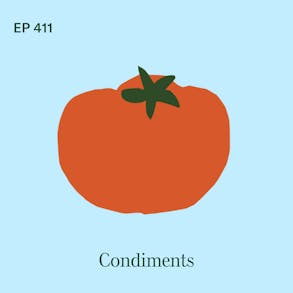
LISTEN TO THIS EPISODE
Episode Description
Can your baby eat ketchup? What about barbeque sauce? In this episode we're exploring common condiments and whether or not they work for baby-led weaning. Listen to learn how to make no sugar, low salt swaps that will add flavor and make swallowing safer for your baby…all with condiments you already have in your kitchen.
Links from this Episode
- Primal Kitchen Sugar Free Ketchup: https://amzn.to/3UIAX7H
- Baby-Led Weaning with Katie Ferraro program with the 100 First Foods™ Daily Meal Plan, join here: https://babyledweaning.co/program
- Baby-Led Weaning for Beginners free online workshop with 100 First Foods™ list to all attendees, register here: https://babyledweaning.co/baby-led-weaning-for-beginners
Other Episode Related to this Topic

Latest Episodes

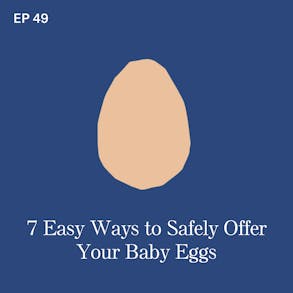

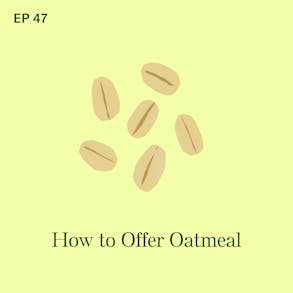

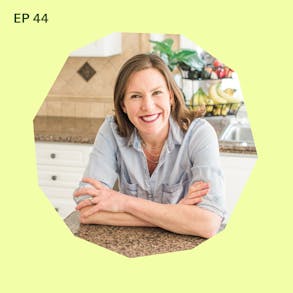
0 (0s):
My kids are getting ready to go back to school, which means I'm gonna be going back to work. And one of the things that I wanna be more prepared about this school year is having a healthy lunch for me all ready to go on work days so that I don't have to waste time prepping food when I'm trying to get all my work done in the few short hours that they're in school. So this school year, I'm really gonna be leaning into Factors. No prep, no mess meal. Factor has 35 different meals with more than 60 add-ons to choose from. Every week, there are six meal preferences to support your wellness goals, whether that's protein plus calorie smart or keto. Factors, fresh, never frozen meals are dietician approved and they're ready to eat in just two minutes.
0 (41s):
So no matter how busy you are, you'll always have time to enjoy nutritious great tasting meals. So if you are getting your schedule back in shape to make today the day that you kickstart a new healthy routine, what are you waiting for? Head to factormeals.com/weaning 50 and use code weaning 50 to get 50% off your first box plus 20% off your next month. That's code weaning W-E-A-N-I-N-G 50, the number 50 at factormeals.com slash weaning 50 to get 50% off your first box plus 20% off your next month while your subscription is active.
0 (1m 21s):
This podcast is sponsored in part by Stokke USA. Have you seen the new enhanced trip trap from Stokke Highchair? So I've used this chair for my own seven kids, plus the babies that I work with in my infant feeding practice. And the only thing that I didn't love about it were the straps. They were stiff and hard to adjust and a real bear to wash. Well, guess what? Stokke listened and they just launched an enhanced Tripp Trapp by Stokke Highchair. It is a totally overhauled five point harness featuring an easy to buckle system that secures in just two clicks and releases quickly with a single button. This one touch release is a total game changer. I just swapped out my old baby sets and harnesses on these chairs for the updated baby sets and harness.
0 (2m 3s):
And I can tell you it took me less than 30 seconds to attach the straps, which by the way, the whole harness is now crafted from softer textiles. They're so easy to adjust the straps and the whole harness is machine washable for really easy cleanup. To celebrate the amazing upgrades on this iconic highchair, I'm partnering with Stokke USA to give away a brand new Tripp Trapp from Stokke Highchair. Just head over to my Instagram at Baby-Led Weaning team before August 16th to enter and win a new chair. And you can see the new versions of the classic baby set and the harness on this newly updated Tripo Trapp from Stokke highchair. When it comes to soy sauce, if you look at regular soy sauce, which is essentially just liquid salt, it has 900 milligrams of sodium per tablespoon.
0 (2m 47s):
And then some families like, well, I'll just do reduced sodium soy sauce, which a lot of people mistakenly call low salt soy sauce. And it's not low salt. Reduced sodium just means it has to have 25% less salt than the super salty regular soy sauce. There's 600 milligrams of of sodium in a tablespoon there, but in our recipes, we swap in coconut aminos. So coconut aminos only have 300 milligrams of sodium per tablespoon. I'm thinking about our chicken adobo recipe. One of the most popular recipes for making chicken thighs. It's so easy, it's so flavorful, but a third of a cup of the coconut aminos spread over 20 servings of chicken in there. That's 80 milligrams of sodium only coming from the coconut aminos in that recipe. And that's totally appropriate for your baby. Not to mention your whole family's gonna love this, lots of flavor without the salt.
0 (3m 30s):
You can do it in certain condiments, like coconut aminos really can help. Hey there, I'm Katie Ferraro, Registered dietician, college nutrition professor and mom of seven specializing in Baby-Led Weaning. Here on the Baby-Led Weaning with Katie Ferraro podcast. I help you strip out all of the noise and nonsense about feeding, giving you the confidence and knowledge you need to give your baby a safe start to Solid Foods using Baby-Led Weaning. Hello and welcome to today's episode. We are talking about condiments and, Baby-Led weaning, do they mix? So what's a condiment? Who cares about condiments? Well, it's a preparation that you usually add to the food after the fact, right after you're done cooking with it.
0 (4m 14s):
And the job of a condiment is to impart a specific flavor or it helps enhance the taste of the dish. And so in this episode, I want to talk about condiments as they pertain to babies, covering what basic condiments you might already have in your kitchen and whether or not they fly for feeding your baby. We'll look at particular ingredients that you wanna avoid, either because of choking hazards or they might be injurious to your baby's health at a certain age. We can talk a little bit about how condiments help improve swallowing safety because they provide additional moisture, so they're really helpful If something that you made for your baby turned out a little too dry and you need to soften things up. You oftentimes hear about adding a dipper or a topper, but okay, great. Like what exactly is it that I could be putting on these dry starchy foods like pancakes or proteins like meats.
0 (4m 59s):
And I'm also going to share some simple condiment swaps that you can include while you're cooking, especially if you use soy sauce a lot in your kitchen. You're gonna wanna stick around to the end of this episode because I'll share a super easy, lower salt way to get a similar flavor and mouthfeel as soy sauce, but without all of that sodium. So I like to start each of these solo training episodes with a Baby-Led Weaning tip of the day. And right at the top here, I just wanna share one of my absolute favorite condiments for Baby-Led Weaning. You might already have this in your pantry, but you didn't think about feeding it to your baby. And that's unseasoned rice vinegar. So rice vinegar is made from fermented rice and it's a staple ingredient in asian cooking.
0 (5m 42s):
So seasoned rice vinegar, if you're at the store and you're looking at it like seasoned, is right next to unseasoned. And you might just grab one and not realize that it's remarkably different because seasoned rice vinegar is flavored with salt and sugar. And typically we want to avoid both of those for babies so that they can learn to taste the flavors of the foods that we're offering, and not all the salt and the sugar. But unseasoned rice vinegar, which is incredibly flavorful, doesn't contain any additives or flavors. So it's a great default condiment to have in your stock of ingredients. It works wonderfully for pickling, which is a way that you can help soften some foods. But I'll also share how I use unseasoned rice vinegar in some sauce ideas that are low in salt with no added sugar that work for Baby-Led Weaning.
0 (6m 27s):
I wanna share a quick story about sauces. They are wonderful, as I mentioned, for adding additional moisture to your baby's food and making it easier for them to swallow. So the other day, my friend Sarah Copeland, she's on Instagram @edibleliving. She's a cookbook author, she's a recipe developer. She was coming over for dinner with her sister to our house in San Diego. So she lives in New York. We studied abroad in college years ago. We've been friends for over 25 years, and don't get to see her very often. So it was going through my cookbook closet and it was pulling out all of Sarah's cookbooks 'cause I wanted to show my kids. My kids are like, you know, what are kids like? You know? And I'm like, okay, they're not on social media. So it's like, okay, I need to find pictures. Oh, she has pictures of her kids in some of her older cookbooks. I'm like getting all her cookbooks out.
0 (7m 6s):
And I'm going through my cookbook cabinet, which is a disaster, and I have maybe four or five cookbooks all about sauces. So my oldest daughter was like, mom, why do you have all these cookbooks about sauces? I've never seen these before. Then my husband, who I didn't think was listening, he chimed in. He's like, oh, granny bought all of those for her when we started dating because granny said, your mom is a boring cook and sauces make everything better, which is totally true. Sauces are amazing. I I have been known to be a boring cook, which is actually perfect for me since I cook for babies. And they don't give verbal feedback and they eat pretty much whatever you like. But yes, I love a good sauces cookbook and I firmly believe that a sauce can save like even the most boring of meals.
0 (7m 47s):
So let's get into the condiments. I mentioned at the outset that condiments add additional flavors as an aside to the foods that you're making now, do you need to go and make a bunch of additional flavorful condiments for new foods that you're offering to your baby? Heck no. Why might condiments be something that you consider for your baby? First of all, they help make foods softer, right? Any hard or dry or crunchy or crispy foods, we can't feed to babies because of the potential for choking risk. And not a lot of condiments are gonna soften foods. Pickling can soften foods, oftentimes pickling involves using a lot of higher sodium ingredients. But I create recipes in my program where we can pickle to soften certain fruits and vegetables without sodium.
0 (8m 28s):
And spoiler alert, there's a lot of unseasoned rice vinegar being used in some of these recipes. But the point is to add some softening agents, right? To let them get softer so they're not hard, crunchy, or crispy. Now, one of the reasons why I love condiments is because they add moisture, right? Making any dry foods can be a choking hazard. So I mentioned pancakes, they do a bit of different whole grains, a lot of different pancakes, or we do little fritters or we do fry cakes or we bake them in mini muffin loaves. And if you cook it too long or it's a little dry and you don't wanna throw it out, adding a sauce, adding a condiment, can help make these foods safer. I also use a lot of condiments on meats we wanna add, we don't want any dry meats, so we always talk about adding additional, you know, low sodium broth or different dippers or toppers.
0 (9m 10s):
And I'll share five low sodium sauces free recipes that I have for you in this episode. If you want to go make them yourself. 'cause you're just like, ugh, I can't find any lower sodium and no sugar condiments at the store. Hey, we're gonna take a quick break, but I'll be right back. This episode is sponsored in part by Ritual Prenatal Vitamins. Are you still taking your prenatal vitamin As a dietician, I know I always continued my prenatal even after I gave birth. In fact, the World Health Organization recommends continuing your prenatal until you start weaning. But not all prenatals are created the same and Rituals Essential for women prenatal supplements contain science-backed formulas, third party testing for heavy metals and microbes, as well as traceable ingredients.
0 (9m 60s):
Ritual Essentials, prenatals support a healthy pregnancy with key nutrients that your body and your baby's body needs. Like methylated folate and nature identical choline that supports your baby's neural tube development, as well as Omega-3 DHA for brain and early vision development and vitamin D that supports fetal bone health. All Ritual products are rigorously tested and they're clean label project certified. You deserve to know exactly what you're putting into your body, especially when it comes to prenatal vitamins and with Rituals, dedication to traceable science and sourcing. You always will see for yourself with 25% off your first month at ritual.com/weaning start Ritual or add essential for women prenatal to your subscription today.
0 (10m 50s):
Again, that website is ritual.com/weaning for 25% off. Let's talk next though about when would condiments not be indicated for babies. So I've mentioned excess salt and added sugar. So the American Academy of Pediatrics recommends zero grams of added sugar for babies up until age two, and then yeah, here and there a little bit of sugar might sneak in your baby's diet. There's naturally occurring sources of sugar and we're totally fine with those from foods like dairy foods and fruits, some vegetables in certain whole grains. But if you look at the added sugars line on the nutrition facts panel of foods, you're offering your baby as a dietician, my recommendation is get as close to zero as you can, as often as you can.
0 (11m 30s):
So we wanna stay away from added sugar. And when you think about condiments like barbecue sauce and ketchup, these foods taste amazing because if you turn it over and look at it, sugar is a primary ingredient, right? Ingredients are listed in order by weight. The higher up on the ingredient list, you see the added sugars, it's gonna correlate with a greater number of grams of added sugar. We mentioned trying to stick to zero grams of added sugar for babies. But if you take ketchup, for example, major national brand, even if it's organic, that doesn't mean it's less sugar, it has organic sugar in it, but a serving of it can have four grams of sugar. So four grams of sugar is equivalent to one teaspoon of sugar. So if you're cooking right, one teaspoon of sugar is the same as four grams, it's the same as a sugar cube or a packet of sugar like if you were at your coffee shop.
0 (12m 12s):
And we just wanna steer clear of that for babies if we can. So a lot of the condiments that you'll find at the store have added sugar. They also might have excess salt. My general rule of thumb is I'm looking for less than a hundred milligrams of sodium in a packaged food that I'm serving to my baby. And a lot of condiments are gonna be hard pressed to find less than a hundred milligrams, although there are some fines out there, and I'll share those today as well. Any condiment that's super spicy that could be injurious to your baby's health, we wanna steer clear of if a condiment is sticky like tahini or peanut butter, we can modify these to make them safe for babies. But any sticky foods that could potentially become lodged on the sides or the roof of your baby's mouth and cause a choking risk, we don't wanna offer those. There are some condiments that contain raw eggs. So if you're buying mayonnaise from the grocery store or mayonnaise, however you prefer to pronounce it, it's generally gonna be pasteurized because it's gonna be a shelf stable product.
0 (12m 59s):
But if you're making homemade mayonnaise and it has raw egg yolk in it, that's not something that we want to offer to baby because of the potential for food borne illness risk.And then any condiment that contains honey honey's not appropriate for babies under the age of one because of the risk for botulism. So what are some examples of condiments in your house? I'm gonna run through a list. This is actually a list from real simple 12 common condiments in the kitchen. I'm a huge fan of real simple. That same friend Sarah Copeland, she used to be, I believe the food editor for Real Simple. And when I was a Peace Corps volunteer in after college, I lived in Nepal and I was hard up for anything to read. So she would always send me every issue of Real Simple magazine.
0 (13m 39s):
I became a huge fan. She then went on to work for Oprah magazine and did food there and I got every single Oprah magazine. I was like so popular in Peace Corps in Nepal because I had all these magazines from the United States and we would read them cover to cover. So Real Simple has a place in my heart, and here's a list of condiments and then I'll give my little spin on how I would or would not use them for your baby. Starting with mayonnaise mentioned commercial ones have pasteurized eggs, so you're okay, you just wanna watch out for any homemade mayonnaise that would have raw egg yolk, ketchup, as I mentioned, usually too much salt and sodium. Now I do like if you're like not into making your own ketchup, which I definitely am not. I do like the Primal Kitchen brand. This is not sponsored at all by them. I previously have been an affiliate for Primal Kitchen.
0 (14m 19s):
I no longer have any financial affiliation with them, but I just love their unsweetened ketchup. It has zero grams of added sugar, 105 milligrams of sodium, which is actually quite low. your baby generally doesn't eat a full tablespoon of ketchup. Well, it depends. Some babies really do like ketchup, but that's a good one. If you just wanna like buy a ketchup, the Primal Kitchen, unsweetened ketchup. As far as hot sauce goes a dash or two, we use it a lot in a different recipes. If you're a hot sauce fan, your baby can gradually learn to eat those as well. Peanut butter, a great way to introduce peanut protein. But of course, sticky foods like nut butters need to be thinned out until they slide off of your stainless steel spoon. So you can mix unsweetened smooth peanut butter with breast milk or formula or unsweetened apple sauce as a way to have your baby self feed peanut to do peanut protein.
0 (15m 2s):
Maple syrup is on the list on is it added sugar. So we wanna skip that for children up into age two. Worcester sauce is another popular condiment. Now an interesting thing about Worcester is that it contains anchovies, which are fish perfectly fine. We want your baby to have fish. It's one of the big nine allergenic foods. Do that early and often, but just be aware you want your baby to have had fish a number of times on its own without reaction before you introduce a food that contains Worcester sauce. And Worcester sauce in a teaspoon only has 65 milligrams of sodium, and I use it quite frequently. I was just kind of looking through my 100 First Foods daily meal plan. In our program, we use Worcester sauce in our turkey meatloaf recipe. It's in the beef and barley stew recipe.
0 (15m 42s):
It's in our mini mushroom meatloaf recipes. I have 20 weeks full of Baby-Led Weaning meal plans for you to get all hundred foods in before your baby turns one.If you wanna check those out, they're in my program. Baby-Led \Weaning with Katie Ferraro and that's at babyledweaning.co/protein. Back to the list of condiments. Tahini is another popular one. I love Tahini at sesame seed paste. It's a wonderful way to introduce your baby to the potentially allergenic food sesame, but it has the consistency of peanut butter or almond butter, and as such, it needs to be thinned out. I use Tahini all the time in our program to help introduce your baby to sesame. I love it, but again, thin it out so it's not a choking hazard. Harissa. So, harissa is a great condiment.
0 (16m 24s):
It's a combination paste of chili and olive oil and spices. Some are spicier than others. I kind of like it 'cause they did a lot of the hard work for you. I use harissa on occasion. If you're scared or unsure about how to season foods for your baby babies, don't have to eat bland foods and don't be shy about adding seasoning. Go listen to episode 48. It's with con koya from Spice Spice Baby. She's teaching How to Flavor season and spice your baby's food. That's at blw podcast.com/48. Another condiment is sesame oil. It's got a great toasty flavor. It's used a lot in asian inspired recipes. One thing about sesame oil though is that usually people who have food protein allergies like sesame, they can generally eat highly refined oils made from those foods.
0 (17m 4s):
So for example, like if you're allergic to peanut, you can eat peanut oil. If you're allergic to soy, you can generally eat soybean oil, but sesame oil is not highly refined. And as such, if your baby is allergic to sesame, you need to avoid sesame oil. Barbecue sauce, I mentioned it earlier a lot of times the problem is that there's added sugar in it. If you've ever made barbecue sauce, my mom loves her barbecue sauce recipe and I was like, it's so good. Of course it is because it has a ton of ketchup in it with all that added sugar, then a ton of brown sugar. Then here she has other white sugar in it, a vinegar in it. Basically there's a lot of sugar in good barbecue sauce. And then if you buy sugar free barbecue sauce, it has a ton of salt in it. And if you buy salt free barbecue sauce, it has a ton of sugar in it. So I kind of steer clear of the barbecue sauce early on and I work on making fatty cuts of meat that are nice and moist that are safe for the baby to eat.
0 (17m 49s):
And then you don't need the sauce. As an aside, my husband is from Texas and every time we go there and we eat barbecue, I really love barbecue sauce. And I'm like, why is there not barbecue sauce here? And he's like, if the barbecue meat is good at barbecue, you shouldn't need sauce for it. And I was like, I disagree. I think the barbecue sauce makes it better. But that is a matter of personal preference. Like a lot of things in barbecue are.
0 (18m 48s):
Hey, we're gonna take a quick break, but I'll be right back. Looking at soy sauce. Okay, so soy sauce is a tough one, right? Because like what is soy sauce? Soy sauce is literally liquid salt. Okay? So if you take a regular soy sauce, there's about 900 milligrams of sodium in a table spoon. So that's like nine times the maximum amount in a serving of something that I would usually serve to a baby. So like regular soy sauce is out, it's liquid salt and then reduced sodium soy sauce. The one that's generally like in the green bottle, let's say if you're at a restaurant or the grocery store, people mistakenly call that low sodium soy sauce all the time. It is not low sodium. Low sodium would have to mean it's less than 140 milligrams per serving. So reduced sodium just means that a food has to have 25% less sodium than what the food normally has.
0 (19m 31s):
So like reduced sodium soy sauce is not low sodium, it's just 25% less than like the super high sodium liquid salt of regular soy sauce, reduced sodium soy sauce as 600 milligrams of sodium per table spoon. So what I use in place of soy sauce for recipes that like absolutely required. And the one that comes to mind, I'm thinking of chicken adobo. This is one of our like most popular recipes. There's a million different ways to make chicken adobo in Filipino food culture, but it always involves soy sauce. We sub coconut aminos. So a tablespoon of coconut aminos only has 300 milligrams of sodium. So it's literally half of what you would get in reduced sodium soy sauce. So a third of a cup of coconut aminos, which is what's in our recipe for chicken adobo.
0 (20m 15s):
It's over 1500 milligrams of sodium in the whole recipe. But because there's 20 portions of chicken in that recipe, it works out to about 80 milligrams of sodium from coconut aminos per recipe. In all of my recipes in my 100 First Foods daily meal plan inside of my program, they all have less than a hundred milligrams of sodium per serving. Okay, will your baby die if they eat more than a hundred milligrams of sodium? Of course not. But on average, I'm trying to keep it below that so that these recipes that you're making for your baby, they're learning how to taste the flavor of the foods and not necessarily the really salty stuff. So check out coconut aminos, they differ. So I use the one from Trader Joe's. It's one of the lower sodium ones that I found, but, but if you can't find it, there's lots of other brands. Just look for the ones that have the lowest amount of sodium.
0 (20m 55s):
Know that they're not salt free, but it's a really good replacement. We do a one-to-one swap for soy sauce in recipes and you can cut the sodium. I mean, it's a third of the amount of sodium that you would find in regular soy sauce. So that's the lowdown on condiments and most of them work just fine with baby lid. We need, if you want to grab five low sodium sauce recipes to make foods safer to swallow for your baby, I have a free feeding guide called Five Low Sodium Sauces for Safer Swallowing. This is a feeding guide that has five recipes. So the five sauce recipes that are in there, if you wanna check 'em out, got a Japanese sesame sauce. This is a Goma Dare, it's so good. Great way to introduce sesame to your baby, goes great on different Asian foods.
0 (21m 35s):
Asian recipes pretty much goes great on everything. I've got a low sodium marinara sauce. 'cause if you're looking at pasta sauce at the store, you're gonna be like, ugh, there's either too much sugar or too much salt, or too much of both. Super easy, low sodium marinara sauce that you can use that your whole family will love and make a ton of this. It's also cheaper than buying store bought pasta sauce. I've got a Chimichurri recipe in that feeding guide that goes great on the different meats that you're making for your baby. An aioli sauce, which I love, super flavorful, a nice way to soften up lots of different starchy foods. And then I have a peanut sauce inside of that feeding guide. Again, it's five low sodium sauces to make swallowing safer for Baby-Led Weaning. If you click the link in the description where you're listening to this, you can download that feeding guide for free.
0 (22m 18s):
I will put a couple more resources related to condiments on the show notes page for this episode, which you can find at blwpodcast.com/411. Thank you so much for listening. Happy feeding, and go to town on some of those condiments for baby Led Weaning.
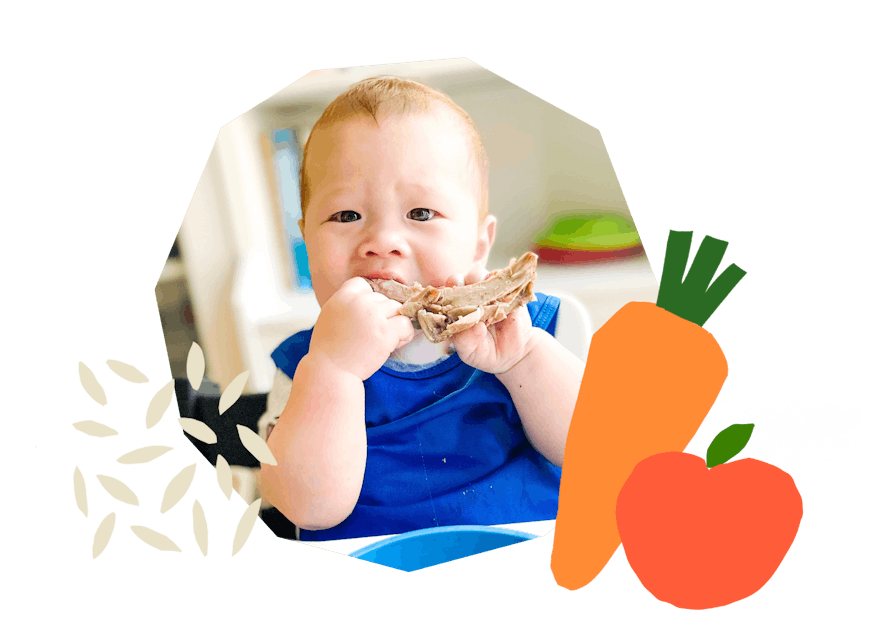
The Program Baby-Led Weaning with Katie Ferraro
A step-by-step digital program for starting solid foods safely and navigating the original 100 FIRST FOODS™ meal plan with baby-led weaning.
 EXPERT-LED, PROVEN APPROACH TO EATING REAL FOOD
EXPERT-LED, PROVEN APPROACH TO EATING REAL FOOD CONCISE VIDEO TRAININGS TO MASTER BABY-LED WEANING
CONCISE VIDEO TRAININGS TO MASTER BABY-LED WEANING 100 FIRST FOODS DAILY MEAL PLAN WITH FOOD PREP VIDEOS
100 FIRST FOODS DAILY MEAL PLAN WITH FOOD PREP VIDEOS
Baby-Led Weaning for Beginners Free Workshop
Is your baby ready to start solid foods, but you’re not sure where to start? Get ready to give your baby a solid foundation to a lifetime of loving real food…even if you’re feeling overwhelmed or confused about this next stage of infant feeding.
Get baby-led weaning recipes and tips delivered to your email inbox.

